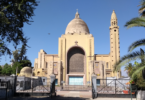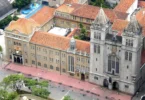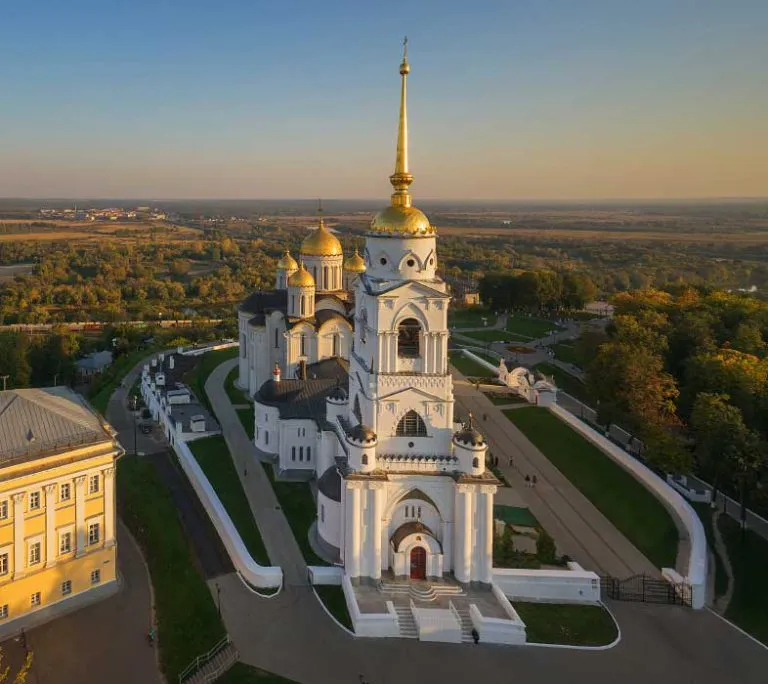
Introduction
The Dormition Cathedral in Vladimir (Assumption Cathedral) was a mother church of Medieval Russia in the 13th and 14th centuries. It is part of a World Heritage Site, the White Monuments of Vladimir and Suzdal. The Dormition Cathedral is an outstanding monument of white-stone architecture of pre-Mongol Russia. Today, it is the cathedral of the Russian Orthodox Church and the National Museum.
Historically, before the rise of Moscow, it was the main cathedral of Vladimir-Suzdal Russia. This cathedral is one of the few temples with preserved frescoes of Andrei Rublev. In 1992, the Dormition Cathedral was included in the list of UNESCO World Heritage.
The main shrine of Vladimir is its majestic and beautiful Assumption Cathedral. Once it was the main church of Vladimir principality. Its construction was initiated by the glorious Prince Andrei Bogolyubskii in 1158.
However, it looked somewhat different then: it had only one dome and could accommodate only two thousand people. Nevertheless, even in that form the cathedral became the prototype for the future Assumption Cathedral in Moscow. The cathedral was intended for important events: coronations of Vladimir princes, and blessings of soldiers going to battlefields.
Its new face the cathedral acquired after the fire of 1185, which had heavily damaged the interior of the church. The heir of Bogolubsky, the Prince Vsevolod the Big Nest, decided to improve the architecture of the cathedral. He surrounded the building by galleries, on the corners of which the new gilded domes appeared.
As a result, the cathedral square become even bigger than before and its new look become even more beautiful, more solemn, and more elegant. However, the Assumption Cathedral was destined to suffer again and again. First came the invasion of Mongol hordes that set fire to the cathedral, where the princely family took refuge. The Cathedral was heavily burned but was not destroyed.
History of Dormition Cathedral, Vladimir

In 1408 the interior design of the cathedral was taken care by the well-known icon painter, Andrei Rublev and his friend Daniel Chyorny. But unfortunately, the magnificent frescoes have survived only partially: the fires and looting did their work; by the 18th century the cathedral had dilapidated and dreary appearance.
Thanks to the restoration of 1888-1891 the Assumption Cathedral received its original look. Today the Assumption Cathedral stands on the top of a high hill and is the integral part of the city’s panorama. The tourists enter through the high tower, which is also a remarkable example of architecture.
The outside decoration of the cathedral is rather impressive – high portals with carved capitals of columns and richly carved stone arches highlight the front entrance to the cathedral. The drum of the central dome is decorated with 12 windows. Equally beautiful is the interior of the church: the floor is paved with mosaics; the walls are painted with beautiful murals. Relatively well preserved are Rublev’s frescoes related to the theme of the Doomsday. It used to the largest iconostasis in Russia in the 15th century.
Besides, Vladimir Assumption Cathedral is known for its icon of Vladimir Mother of God. This Byzantine icon, painted by Luke the Evangelist in the 12th century was donated to Yuri Dolgoruky by the Patriarch of Constantinople. The son of Yuri Dolgoruky, Prince Andrei Bogolyubskii brought it to Vladimir, the new capital of Russia.
The icon was placed into the Assumption Cathedral. Vladimir Icon of the Mother of God is associated with numerous miracles. The icon was revered as the patroness of the Russian land. In 1408 the icon was moved to Moscow; now it is kept in the Tretyakov Gallery.
The cathedral is the burial place of St. Prince Alexander Bogolyubsky, his son Gleb as well as Georgy Vsevolodovich. The walls of the cathedral keep the tombs of a few Vladimir princes including another son of Bogolubsky, Izyaslav and local bishops.
Temple was closed from 1927 to 1944.
Virgin of Vladimir

The Virgin of Vladimir, also known as Vladimir Mother of God, Our Lady of Vladimir, and the Theotokos of Vladimir, is a 12th-century Byzantine icon depicting the Virgin and Child and an early example of the Eleusa iconographic type. It is one of the most culturally significant and celebrated pieces of art in Russian history. Many consider it a national palladium with several miracles of historical importance to Russia being attributed to the icon. Following its near destruction in the thirteenth century, the work has been restored at least five times.
The icon was painted by an unknown artist most likely in Constantinople. It was sent to Kiev as a gift before being transferred to the Assumption Cathedral in Vladimir. It is traditionally said that the icon did not leave Vladimir until 1395, when it was brought to Moscow to protect the city from an invasion by Timur, although the historical accuracy of this claim is uncertain. By at least the sixteenth century, it was in the Dormition Cathedral in Moscow where it remained until it was moved to the State Tretyakov Gallery after the Russian Revolution.
It was subject to an ownership dispute in the 1990s between the gallery and Moscow Patriarchate, which ended with its relocation to the Church of St. Nicholas in Tolmachi. An arrangement was made to operate the church with dual status as a house church and part of the museum. The icon remains there today, and is only accessible via an underground passage from the gallery to the church, where liturgies are still held.
History of Virgin of Vladimir

The icon is dated to the earlier part of the 12th century, and arrived in Russia around 1131. This is consistent with the account given in the Russian Chronicles. Similar to other high quality Byzantine works of art, it is thought to have been painted in Constantinople. Only the faces are original, with the clothes repainted after suffering damage when a metal cover or riza was placed over them and in a fire in 1195.
In about 1131, the Greek Patriarch of Constantinople sent the icon as a gift to Grand Duke Yuri Dolgorukiy of Kiev. Academic Sona Hoisington attributes this in part to a greater effort by Byzantines to convert and Christianize the Slavic peoples at the time. It was kept in a Vyshhorod nunnery until Yuri’s son, Andrey of Bogolyubovo, brought it to Vladimir in 1155.
In a traditional account the horses transporting the icon had stopped near Vladimir and refused to go further. Accordingly, many people of Rus interpreted this as a sign that the Theotokos wanted the icon to stay there. The place was named Bogolyubovo, or “the one loved by God”. Andrey placed it in his Bogolyubovo residence and built the Assumption Cathedral to legitimize his claim that Vladimir had replaced Kiev as the principal city of Russia. The icon was soon moved to the Assumption Cathedral after its consecration in 1160.
Following the consecration of the Assumption Cathedral, which was soon followed by other churches dedicated to the Virgin, there is no record of the icon ever leaving Vladimir until 1395. However, its presence did not prevent the sack and burning of the city by the Mongols in 1238, when the icon was damaged in the fire. It was restored soon after the event, and again in 1431 and in 1512.

Transfer to Moscow
A legend formed that the icon was painted by Luke the Evangelist from life; the first written account of this story dates back to 1512. The intercession of the Theotokos through the image has also been credited with saving Moscow from Tatar hordes in 1451 and 1480.
The image was brought from Vladimir to Moscow in 1395, during Tamerlane’s invasion. The site where the Muscovites met the Vladimir delegation is commemorated by the Sretensky Monastery which is considered to be built where it occurred. However, no archeological evidence supports this claim, and much of the fifteenth-to-sixteenth century church was destroyed after renovations by the Russian Orthodox Church. Vasily I of Moscow spent a night crying over the icon, and Tamerlane’s armies retreated the same day. The Muscovites refused to return the icon to Vladimir and placed it in the Dormition Cathedral of the Moscow Kremlin.
David Miller suggests that the icon was in fact normally still in Vladimir, with some excursions to Moscow, until the 1520s. Crediting the icon with saving Moscow in 1395 does not appear in sources until the late 15th century and the full version of the story until accounts of 1512 and then the 1560s.
From the 16th century, the Vladimirskaya began to be featured as an important symbol in a series of politicized legends linking Moscow to pre-Mongol Rus and positioning it as the centre of Christianity after Rome and Byzantium initially to sustain the imperial pretensions of Ivan IV, and later to influence state policy under the Riurikid and Romanov dynasties.
Post Revolution
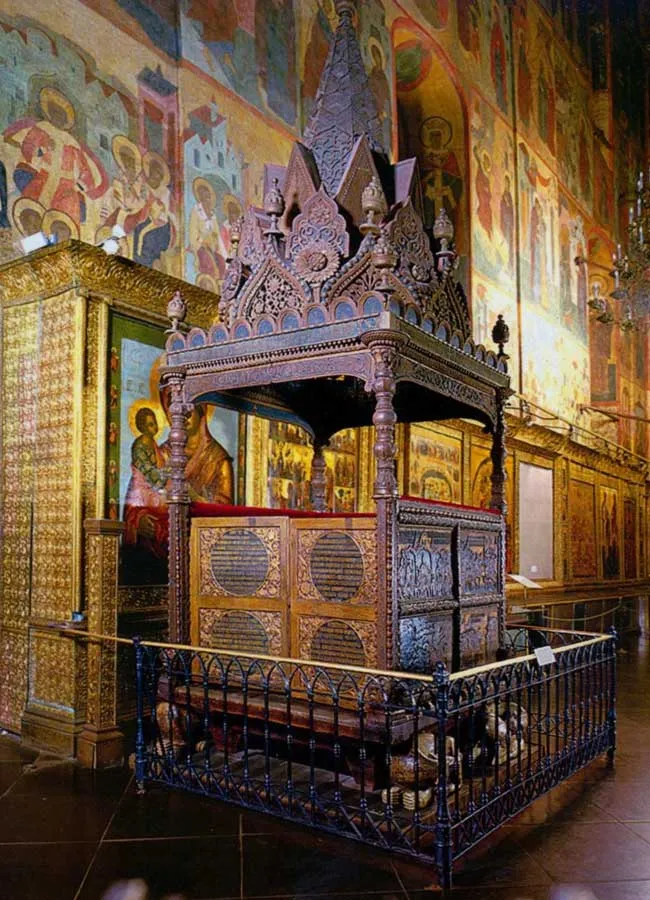
Under the Bolsheviks, the icon came into the possession of the State Tretyakov Gallery. Displayed as a work of art, it was first put on display in the gallery in 1930 and kept there for at least the next 11 years. During the Battle of Moscow, Joseph Stalin allegedly had the icon flown around the city as the Germans began to invade. This was first described by Moscow city official Viktor Volokhov in his book.
In 1993, it was moved to the Epiphany Cathedral for a Divine Liturgy in the wake of tensions between President Boris Yeltsin and the Russian Duma. Though it was damaged during the excursion, it was soon restored and given to the Church of St. Nicholas in Tolmachi.
Description
The icon is a tempera painting on wood, 106 by 69 centimetres (42 in × 27 in) in size, with the central 78 by 55 centimetres (31 in × 22 in) portion being original and the rest being a later expansion undertaken possibly to accommodate a larger riza. The icon depicts Jesus Christ as a child being held in the arms of his mother, Mary. They embrace cheek to cheek, with the child gazing towards and reaching for Mary. She holds him with one arm and solemnly looks out towards the viewer.
The faces and hands are painted with greenish olive sankir, a mix of ochre pigment and soot, and transparent layers of brighter ochre; the child’s face is rendered in a lighter shade than the mother’s, perhaps to reflect the difference in their age. The child’s clothes are painted with dark ochre and gold. The original painting bore the inscription, an abbreviation for ‘Mother of God’, of which only parts survive.
In its nine centuries of existence, the icon has been restored and overpainted at least five times to deal with damage and deterioration, including a fifteenth century restoration thought to have been led by Andrei Rublev. It is mainly the faces of Mary and Jesus and the gold ground above her head that are original twelfth-century paint.
In the past, the icon has been covered with several elaborately designed oklad and riza (revetments) which caused damage to the frame. The reverse, which is much less well known, contains an image of the Hetoimasia (‘prepared throne’) and instruments of Christ’s Passion that was painted in c. 14th century (prior to that the reverse side had a painting of an unidentified saint).
Among icons of Virgin Mary with Jesus, Our lady of Vladimir is classed as an Eleusa icon, due to the tender attachment between mother and child. Theologians and believers have also commented upon the icons symbology and the religious sentiments it inspires. Contemplating the icon, theologian Henri Nouwen, remarked that the Virgin’s eyes glance at neither the child or the viewer but appear to “look inward and outward at once”; that her free hand gestures towards the baby to “open a space for us to approach Jesus without fear”; and, that the child is shown as “a wise man dressed in adult clothes.”
Literary scholar, S. S. Averintsev interpreted the mix of maternal tenderness and poignant sorrow seen in Mary’s expression, as representative of the emotions generated by the events of Nativity and Calvary, respectively. Jesus’s bare feet are seen as symbolizing his physical reality; his garments of gold, the Kingdom of Heaven; and the three stars on Mary’s dress (one occluded by the child), “her virginity before, during and after her son’s birth.”
Its artistic quality has been highly praised. Art historian David Talbot Rice said that “[Our Lady of Vladimir] is admitted by all who have seen it to be one of the most outstanding religious paintings of the world.” Art historian George Heard Hamilton praises its “craftsmanship and conception”, and notes how in its representation of the subject’s faces, the icon subtly transitions from its normal use of contour lines to a refined surface texture.
It is painted in an artistic style typical for Byzantine art of the period with features including smaller mouths, refined eyes, and elongating Mary’s nose. However, by avoiding the use of demarcating line, as became common in later Byzantine art, and by setting up the complex interplay of the mother and child’s glances, the icon adds to the illusion of life in the piece. The child’s features are reminiscent of classical sculpture, though the artist renders an expression truer to an actual infant’s. The expressive and humanistic character of the icon differentiates it from earlier Byzantine art and exemplify the artistic developments seen during the Komnenos dynasty.

Location and Display
Our Lady of Vladimir is on display at the Church of St. Nicholas in Tolmachi. As a result of an agreement between the Tretyakov and Moscow Patriarchate, the church is both an active Russian Orthodox house church and functioning museum. Previously, there had been a contentious ownership dispute between the two.
In 1997, the Tretyakov completed a full restoration of the church. Security improvements to store and display art were added, and an underground passageway was additionally made to connect it to the State Tretyakov Gallery. In order to house the famous icon, a temperature controlled bulletproof glass case was commissioned.
On 7 September 1996, Our Lady of Vladimir was first installed in the special case located within the church, and the next day Patriarch Alexy II consecrated the church. According to Archpriest Nikolai Sokolov, the rector for the church, the case would able to withstand the firing of a Kalashnikov rifle as well as many other potential hazards.
Due to its dual status as both church and museum, visitors are allowed to pray before the icon and divine Liturgies are regularly held on selected days. However, visitors can only enter the church through the Tretyakov Gallery and via the underground passage way.
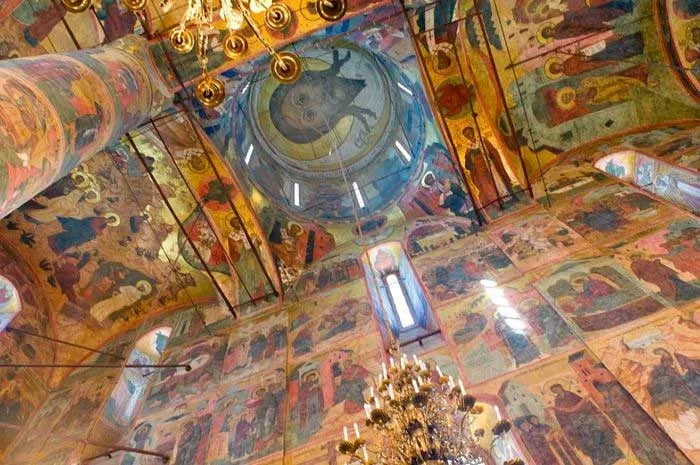
Feast Day
As a sign of gratitude for their deliverance on three occasions, a feast in honor of the Vladimir Mother of God was designated to be celebrated on the days of May 21, June 23 and August 26.
To commemorate these events, the following feast days were established: May 21, in honor of Moscow’s deliverance from Crimean Khan Mehmad-Girey in 1521; June 23, in honor of Moscow’s deliverance from the hordes of Khan Ahmet in 1480; and August 26, in honor of Moscow’s deliverance from Tamerlane’s army in 1395.
Mass Time
Every Days
Church Visiting Time
Contact Info
Bolshaya Moskovskaya Street,
56, Vladimir, Vladimir Oblast, Russia, 600000.
Phone No.
Tel : +7 492 232-52-01
Accommodations
How to reach the Cathedral
Semyazino Airport (Russian: Аэропорт Семязино) in Russia located 6 km west of Vladimir is the nearby Airport to the Cathedral.
Vladimir-Passenger Train Station in Vladimir, Russia is the nearby Train Station to the Cathedral.




